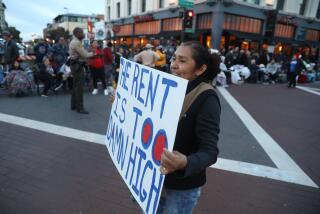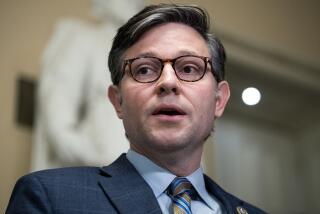As the rich-poor gap widens, so does debate about what it means
Reporting from Reading, Pa. — Fewer than 50 miles separate the poorest city of its size in the U.S. from the prosperous suburbs of Philadelphia, a corridor of wealth with few rivals. There’s an $80,000 difference between the average household incomes. The poverty rates — Reading’s is above 40% — don’t even compare.
But when it comes to the gulf between rich and poor in the U.S., the residents of Reading and the tony locales down the road sound more alike than one might expect.
“I do think the system is fundamentally unfair in some ways and skewed toward people with a lot of influence and control,” said John Royer, a corporate lawyer and registered Republican from Wayne, Pa. “In the back of my mind, I worry, ‘If the gap continues and widens, could this be the beginning of major social unrest?’ ”
Russell Grate is a 44-year-old unemployed warehouse worker from Reading who, even when he had a job, made about as much in a year as the tuition at the private school where Royer sends his children. Grate’s view of Congress is more direct: “Everything they do is for the rich. Washington is doing nothing for the working poor in this country. If you don’t have money, you’re nobody.”
As politicians trade accusations of class warfare and corporate cronyism, and protesters occupy public property across the country, a persistent and complex conversation about income and opportunity in the U.S. is taking place on a swath of common ground.
Polls show that a large majority of Americans sees a widening gap between the haves and the have-nots. There is significant consensus that the country’s political and financial systems are skewed in favor of the wealthy. While income and party affiliation influence individual opinions on the urgency of the problem and how the government should respond, there is substantial support — typically 60% of voters — for increasing taxes on top earners.
The failure of a congressional “super committee” to compromise last week on taxes, entitlement cuts and other measures to reduce federal deficits has ensured that the income disparity debate will be a major theme of the 2012 election cycle.
The stalemate hardened both parties’ positions. Republicans held fast against proposed tax increases on the affluent that the Obama administration and Democrats advocated. Democrats resisted major changes to the social safety net unless new tax revenue was part of the deal.
Sitting squarely in contested territory in a battleground state, this pocket of southeastern Pennsylvania is among a handful of places poised to weigh in.
The area voted solidly for President Obama in 2008 and is far from a conservative bastion, but it took a right turn in state and congressional elections last year. Reading and the suburbs just miles down the Benjamin Franklin Highway share the same congressional district, represented by a Republican.
Like the rest of the country, Pennsylvania has seen its richest residents maintain or improve their economic stature while its poor slide farther down the ladder.
From 1979 to 2007, the richest 1% of Americans increased their after-tax income by 275%, according to a recent report by the independent Congressional Budget Office. Meanwhile, earners in the bottom one-fifth saw their incomes grow by 18%. Because of changes to rates, exemptions and deductions, the tax code did less to even out income distribution, the budget office found.
Reading, an industrial hub that once made eyeglasses, stockings and automobile parts, now makes very little. In the 2010 census, the city barely inched out Flint, Mich., for the largest percentage of people living in poverty in a city with a population of more than 65,000.
The wooded suburbs of Philadelphia, fueled by a boom in the biotech and health industries, have remained havens of wealth, good schools and stately colonials. Most of those interviewed there said they were unaware of Reading’s dismal ranking.
Similarly, Grate, whose family is living off his wife’s salary from Burger King, had little knowledge of life in the upscale suburbs — just what he gleaned from his days driving a delivery truck of medical supplies.
“I’ve been there. I’ve seen the houses,” he said.
Americans say they see the trend: In a recent Washington Post-ABC News poll, 60% of people interviewed said they believed the income gap was widening.
At the same time, a majority of those polled said they did not see the country as divided along income lines, illustrating a near-sacred belief in American culture of the notion of economic opportunity. A Pew Research study in March found large majorities believed people who worked hard could get ahead and “everyone has it in their power to succeed.”
“The idea that there are haves and have-nots suggests that mobility doesn’t exist,” said Michael Dimock, associate director at the Pew Research Center. “Americans believe in the idea of mobility and opportunity and want to hold to that value.”
Democrats and Republicans have tailored their messages to different elements of these sometimes-contradictory views on income disparity. Democrats argue the Republican policies tip the scales for the rich. Republicans counter that Democrats are promoting class warfare that undermines economic opportunity for everyone.
“It’s not that I mind paying taxes,” said Randy Meier, a Republican and executive at a health services company from Villanova, Pa. “I just don’t have a lot of confidence that the government knows what they’re doing with the resources.”
Despite the differences, members of both parties were quick to point to the tax code as the primary symbol of inequity. Loopholes, deductions and breaks all favor the wealthy, Grate said.
“I feel like we pay all the damn taxes,” he said.
Royer, the lawyer, agreed.
“We ought to make people pay a little bit more, a little more revenue,” he said. “I do think there’s got to be some kind of fundamental fairness.”
kathleen.hennessey@latimes.com
More to Read
Sign up for Essential California
The most important California stories and recommendations in your inbox every morning.
You may occasionally receive promotional content from the Los Angeles Times.











